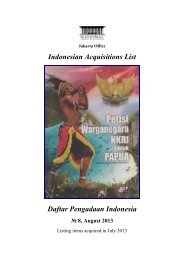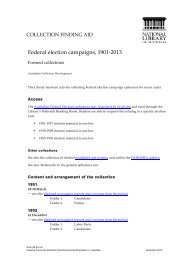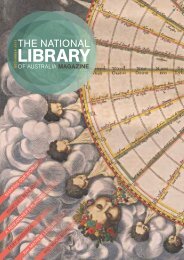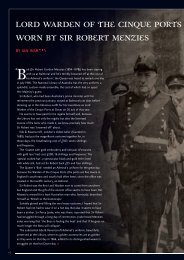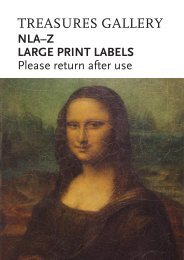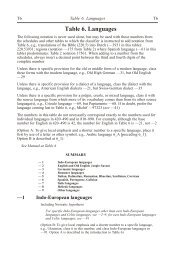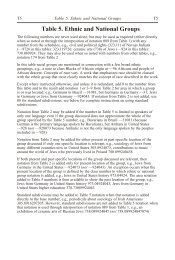Ernest Auguste Goupil - National Library of Australia
Ernest Auguste Goupil - National Library of Australia
Ernest Auguste Goupil - National Library of Australia
Create successful ePaper yourself
Turn your PDF publications into a flip-book with our unique Google optimized e-Paper software.
<strong>Ernest</strong> <strong>Auguste</strong> <strong>Goupil</strong><br />
a young man and his art<br />
Elizabeth Truswell reveals the<br />
gentle character and poignant<br />
death <strong>of</strong> a French artist who<br />
joined an 1837 expedition to<br />
Oceania and the South Pole<br />
Artists played a key role in the<br />
major European expeditions <strong>of</strong> the<br />
eighteenth and nineteenth centuries.<br />
Theirs was the task <strong>of</strong> recording the places<br />
and people, and the fauna and flora that they<br />
encountered. Science was trumpeted as the<br />
reason for much <strong>of</strong> the exploration <strong>of</strong> the<br />
New World, but there is little doubt that<br />
most ventures were driven by nationalism and<br />
the impulse to secure colonial possessions,<br />
and by the idea that all the treasures <strong>of</strong> the<br />
world could be recorded, claimed and, where<br />
possible, collected.<br />
A French expedition to ‘Oceania and the<br />
South Pole’ departed on two navy corvettes,<br />
the Astrolabe and the Zélée, from Toulon on<br />
7 September 1837. Onboard the Zélée was a<br />
young artist by the name <strong>of</strong> <strong>Ernest</strong> <strong>Auguste</strong><br />
<strong>Goupil</strong>. The vessels were being commanded<br />
by Jules Sebastien-César Dumont d’Urville<br />
(1790–1842), who ranks alongside Captain<br />
James Cook in his skill as a navigator. It<br />
was his second voyage to the Southern<br />
Hemisphere, his orders being ‘to further<br />
hydrography, trade and science’. In addition,<br />
King Louis-Philippe <strong>of</strong> France requested that<br />
the expedition attempt to cross the Antarctic<br />
Circle and penetrate beyond 74° south, the<br />
latitude reached by the English sealing captain<br />
James Weddell in 1823.<br />
Very little has been published <strong>of</strong> <strong>Goupil</strong>’s<br />
life and his role aboard Zélée. Most <strong>of</strong> what<br />
we know comes from a eulogy written<br />
anonymously by ‘one <strong>of</strong> his friends, a<br />
companion <strong>of</strong> the voyage’, in volume 8 <strong>of</strong><br />
Dumont d’Urville’s Voyage au Pôle Sud et dans<br />
l’Océanie (1845), held in the <strong>National</strong> <strong>Library</strong><br />
<strong>of</strong> <strong>Australia</strong>. From this account, penned with<br />
great affection, we learn that <strong>Goupil</strong> was born<br />
in 1814 at Chateaudun, in the Loire Valley.<br />
A delicate boy, he resolutely toughened his<br />
constitution by travelling and<br />
painting in the local countryside.<br />
He trained in Paris, tutored<br />
by Jules Coignet (1798–1860),<br />
whose paintings are described as<br />
romantic landscapes, ordered in<br />
their composition, an approach<br />
that clearly influenced his young<br />
pupil. <strong>Goupil</strong> painted, <strong>of</strong>ten in<br />
the company <strong>of</strong> fellow artists,<br />
around the Mediterranean coast<br />
<strong>of</strong> France. He also travelled to<br />
Algiers on a scarcely seaworthy<br />
vessel, and painted in North<br />
above<br />
ernest <strong>Goupil</strong> (1814–1839,<br />
artist), leon Jean baptiste<br />
sabatier (d.1887, lithographer)<br />
Les corvettes louvoyant dans<br />
l'interieur de la banquise le 5<br />
Fevrier 1838<br />
hand-coloured lithograph<br />
30.3 x 47.7 cm<br />
Pictures collection<br />
nla.pic-an9224435<br />
below left<br />
louis le breton (1818–1866,<br />
artist), Adolphe Jean baptiste<br />
bayot (1810–?, lithographer)<br />
Passage du cercle polaire,<br />
le 19 janvier, 1840, parages<br />
Antarctiques 1846<br />
lithograph; 34.5 x 54.5 cm<br />
Pictures collection<br />
nla.pic-an20826696<br />
the national library magazine :: march 2011 :: 27
above<br />
ernest <strong>Goupil</strong> (1814–1839,<br />
artist), leon Jean baptiste<br />
sabatier (d.1887, lithographer)<br />
Île Éléphant, Îles New South<br />
Shetland 1846<br />
lithograph; 34.5 x 54.5 cm<br />
Pictures collection<br />
nla.pic-an20799659<br />
below<br />
ernest <strong>Goupil</strong> (1814–1839,<br />
artist), emile lassalle (1813–<br />
1871, lithographer)<br />
Vue des environs de Port Famine,<br />
detroit de Magellan 1846<br />
lithograph; 34.5 x 54.5 cm<br />
Pictures collection<br />
nla.pic-an20759341<br />
28::<br />
Africa. At 21, he was already exhibiting in the<br />
Paris Salon.<br />
When news <strong>of</strong> Dumont d’Urville’s<br />
proposed new voyage reached <strong>Goupil</strong>, he<br />
eagerly applied for the position <strong>of</strong> artist.<br />
Dumont d’Urville was impressed not only<br />
by the evident skill <strong>of</strong> the young painter,<br />
but also by his sea-going experience. <strong>Goupil</strong><br />
was only 23 years old when appointed by<br />
the Marine Ministry as draftsman to the<br />
expedition. On the Zélée, his engaging<br />
nature made him a popular figure. His<br />
eulogist wrote:<br />
his humour, gentle and joyful, his happy<br />
character, his fresh and open face, reflecting<br />
his lovely soul, earnt the affection <strong>of</strong> all his<br />
travelling companions … the Artist! was<br />
a magic word which brightened faces and<br />
brought a smile to many lips.<br />
The expedition made its first attempt on the<br />
Antarctic during January and February 1838,<br />
crossing the Straits <strong>of</strong> Magellan and meeting<br />
thick ice <strong>of</strong>f the Antarctic Peninsula. The men’s<br />
hopes <strong>of</strong> penetrating further south than James<br />
Weddell were frustrated. The corvettes spent<br />
hazardous days locked in pack ice, before being<br />
freed. Forced to retreat, the expeditioners<br />
explored the islands north <strong>of</strong> the peninsula,<br />
including the South Shetland and Elephant<br />
islands. During the passage into Antarctic<br />
waters, <strong>Goupil</strong> drew constantly, holding his<br />
pencil in frozen fingers, covering the pages <strong>of</strong><br />
his album with drawings <strong>of</strong> the glaçons—the<br />
ice forms which surrounded the men.<br />
Clear <strong>of</strong> the ice, the expedition sailed<br />
into the Pacific and <strong>Goupil</strong> revelled in the<br />
opportunity to draw during brief visits to the<br />
tropical islands en route. He was frustrated,<br />
though, that the vessels rarely stayed long<br />
enough for him to be satisfied with his work.<br />
But it was these islands, so enjoyed by <strong>Goupil</strong>
and his fellow sailors, that were to furnish,<br />
according to his eulogist friend, ‘the germs <strong>of</strong><br />
a terrible scourge that was to take, in a little<br />
while, more than thirty <strong>of</strong> our companions’.<br />
In the eyes <strong>of</strong> his friend, <strong>Goupil</strong>’s dedication<br />
to his art proved his undoing. European sailors<br />
considered the north coast <strong>of</strong> Java notoriously<br />
unhealthy due to ‘miasmas’ arising from<br />
coastal swamps. At Lampung Bay, Indonesia,<br />
<strong>Goupil</strong> spent hours under a hot sun, on the<br />
bank <strong>of</strong> a foetid canal next to a local village.<br />
There, the ships filled their water tanks, which<br />
was probably a fatal move.<br />
Shortly after leaving the Sunda Strait,<br />
there were some 12 men with dysentery on<br />
the Zélée and eight on the Astrolabe. The men<br />
began to die. Dumont d’Urville decided to<br />
make the long dash to the temperate climate<br />
<strong>of</strong> Hobart Town, where he was acquainted<br />
with Lieutenant-Governor Sir John Franklin.<br />
<strong>Goupil</strong> was among the most pr<strong>of</strong>oundly ill.<br />
His companions tried to shield him from<br />
the pain and dying <strong>of</strong> other victims, and<br />
succeeded, in spite <strong>of</strong> narrow spaces and thin<br />
partitions in the ship’s interior. He survived<br />
the two-month long voyage to Hobart, where<br />
the ships arrived in December 1839.<br />
There, Colonel Elliot, acting for the<br />
Lieutenant-Governor, welcomed the French<br />
sailors. Ashore, in a makeshift hospital set<br />
up to accommodate the sick, <strong>Goupil</strong> briefly<br />
rallied, but hope <strong>of</strong> his recovery was short<br />
lived. Sensing that his end was approaching,<br />
he nonetheless appeared calm. He asked for a<br />
glass <strong>of</strong> champagne and:<br />
held the glass in his weak hand, while<br />
Commander Jacquinot, who had a<br />
particular affection for <strong>Ernest</strong>, came to<br />
see him. ‘You see, Commander,’ he said,<br />
making an effort to smile, ‘death is not<br />
as sad as you imagine!’ At the sight <strong>of</strong><br />
this angelic resignation, the tough sailor,<br />
who had seen death close to him without<br />
flinching … turned away to hide his tears.<br />
<strong>Goupil</strong> died during the night <strong>of</strong> 31 December<br />
1839, in the presence <strong>of</strong> his friend M. Honoré<br />
Jacquinot, assistant surgeon <strong>of</strong> the Zélée. The<br />
expedition could not be delayed for <strong>Goupil</strong>’s<br />
funeral, Dumont d’Urville being anxious to<br />
take advantage <strong>of</strong> the short summer to make<br />
another attempt on the ice. An hour after<br />
the death <strong>of</strong> his friend, Jacquinot went back<br />
onboard and the vessels set sail. After <strong>Goupil</strong>’s<br />
death, the role <strong>of</strong> expedition artist fell solely<br />
to Louis Le Breton, assistant surgeon and<br />
naturalist on the Astrolabe.<br />
In Hobart on 4 January 1840, at the<br />
instigation <strong>of</strong> the Lieutenant-Governor,<br />
<strong>Goupil</strong> was accorded a military funeral, with<br />
honours befitting his rank. The Hobart Town<br />
Advertiser recorded the order <strong>of</strong> the funeral.<br />
<strong>Goupil</strong>’s c<strong>of</strong>fin, draped in the French flag,<br />
was accompanied by 50 troopers while four<br />
lieutenants acted as pallbearers. Townspeople<br />
too joined the procession. <strong>Goupil</strong> and a number<br />
<strong>of</strong> his colleagues were buried in the Catholic<br />
cemetery. In 1911, when St Virgils College was<br />
built over the site, the bones were transferred to<br />
Cornelian Bay Cemetery, where a large marble<br />
monument lists the names <strong>of</strong> all the French<br />
sailors who died, either at sea or ashore, during<br />
the devastating dysentery epidemic.<br />
Artists, such as <strong>Goupil</strong>, who had trained<br />
in the classical genre <strong>of</strong> landscape painting,<br />
experienced a certain tension between its<br />
conventions and the demands <strong>of</strong> scientists and<br />
navigators. While <strong>Goupil</strong> seems to have been<br />
driven by a desire to record nature realistically,<br />
his admiration for the classical landscape<br />
painters was clear. His friend reported his<br />
source <strong>of</strong> inspiration thus:<br />
He had written in large letters, on a sheet<br />
<strong>of</strong> paper, these two names: Claude de<br />
Lorrain—Huysmans, and had stuck this<br />
inscription on the front <strong>of</strong> his desk, in such<br />
a way that it was always before his eyes<br />
and his thoughts, the names and the work <strong>of</strong><br />
these two great artists, whom he had chosen<br />
as models.<br />
Claude Lorrain, one <strong>of</strong> the great masters<br />
<strong>of</strong> the seventeenth century, <strong>of</strong>ten drew on<br />
classical antiquity to present nature as serene,<br />
harmonious or majestic; the lesser known<br />
ernest <strong>Goupil</strong> (1814–1839,<br />
artist), P. blanchard<br />
(lithographer)<br />
Canal de Samarang, Iles Java<br />
1846<br />
lithograph; 34.5 x 54.5 cm<br />
Pictures collection<br />
nla.pic-an20824841<br />
the national library magazine :: march 2011 :: 29
ernest <strong>Goupil</strong> (1814–1839,<br />
artist), emile lassalle (1813–<br />
1871, lithographer)<br />
Etablissement Anglais à Port-<br />
Essington, côte N. de l'Australie<br />
1846?<br />
lithograph; 27.2 x 39.0 cm<br />
Pictures collection<br />
nla.pic-an6016310<br />
30::<br />
Flemish painter, Cornelis Huysmans, rendered<br />
landscapes similarly, using rich, warm tones.<br />
While these artists adhered to the strictures <strong>of</strong><br />
the classical genre, they nonetheless represented<br />
a certain reality in nature. Such an approach<br />
impressed <strong>Goupil</strong>, who believed ‘nature alone<br />
could furnish him with his material’.<br />
The <strong>Library</strong> holds 52 <strong>of</strong> <strong>Goupil</strong>’s drawings,<br />
reproduced as lithographs, in the two-volume<br />
Atlas pittoresque; Voyage au Pôle Sud et dans<br />
l’Océanie published in 1846, six years after the<br />
completion <strong>of</strong> the voyage. Close examination<br />
reveals their combination <strong>of</strong> realism and<br />
romanticism. The realism is apparent in the<br />
fine detail, for example, in the rendering<br />
<strong>of</strong> botanical details in Manga Reva in<br />
French Polynesia. His drawings <strong>of</strong> southern<br />
icebergs—some <strong>of</strong> the earliest portrayals <strong>of</strong><br />
these—are also intensely realistic.<br />
However, it is in the careful composition <strong>of</strong><br />
<strong>Goupil</strong>’s drawings that his classical training<br />
is evident. The conventional threefold division<br />
<strong>of</strong> landscape into foreground, middle and<br />
background is clear. In most cases, activity is<br />
focused in the middle ground—the ships in<br />
the ice sit there, as do the human figures—<br />
and this is apparent in his drawing <strong>of</strong> Port<br />
Essington, his only landscape on <strong>Australia</strong>n<br />
soil. He also frequently made use <strong>of</strong> framing<br />
devices, such as the trees that lean inward<br />
over the canal at Samarang, and an effective<br />
repetition <strong>of</strong> forms, as in his dramatic drawing<br />
<strong>of</strong> Elephant Island in which the mountain<br />
masses echo the shapes <strong>of</strong> the foreground<br />
waves. His rendering <strong>of</strong> skies carries more<br />
than a hint <strong>of</strong> the sublime; in his drawing <strong>of</strong><br />
Port Famine in South America, windswept<br />
trees echo the direction <strong>of</strong> the clouds.<br />
For this young artist, like others who<br />
accompanied early exploring expeditions, the<br />
recording <strong>of</strong> science was inextricably linked<br />
with the notion <strong>of</strong> the picturesque. One can<br />
only speculate about what directions his art<br />
would have taken had he not died in Hobart at<br />
the age <strong>of</strong> 26.<br />
elIzAbetH trusWell is a visiting Fellow in<br />
the research school <strong>of</strong> earth sciences at the<br />
<strong>Australia</strong>n <strong>National</strong> university, working largely<br />
on scientific aspects <strong>of</strong> Antarctica. she is also a<br />
practising artist, with an abiding interest in the art<br />
<strong>of</strong> early voyages to that continent<br />
A NAtioNAl librAry <strong>of</strong> AustrAliA coNfereNce, iNcorporAtiNg the KeNNeth biNNs lecture<br />
True STorieS<br />
Writing History<br />
Saturday and Sunday 2–3 April,<br />
<strong>National</strong> <strong>Library</strong> <strong>of</strong> <strong>Australia</strong><br />
Join some <strong>of</strong> <strong>Australia</strong>’s finest writers, historians and<br />
creative artists as they explore the way we write about,<br />
interpret and share our history.<br />
Keynote speaker, Christopher Koch, will deliver the<br />
Kenneth Binns Lecture.<br />
Supported by the Copyright<br />
Agency Limited (CAL)<br />
Cultural Fund, the Ray<br />
Mathew and Eva Kollsman<br />
Trust and Alison Sanchez<br />
SpeakerS, program information, feeS and bookingS: www.nla.gov.au/events/truestories enquirieS: 02 6262 1565



